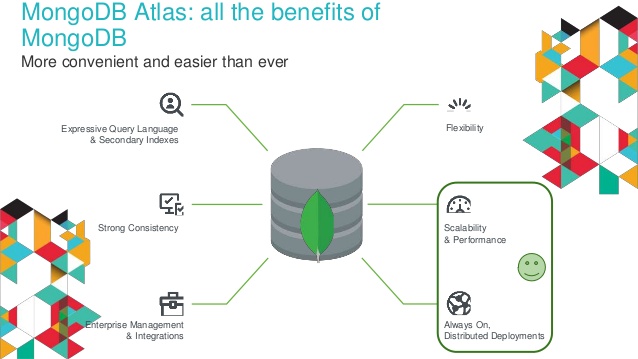Trong guồng quay công việc hàng ngày, chúng ta dành hàng giờ để soạn thảo…
Why build apps on cloud databases like MongoDB Atlas?
IT departments today are being challenged to adopt new and more strategic roles within the organizations they work for. As more and more businesses turn to technology to differentiate themselves from the competition, IT is being challenged to break away from its traditional legacy of operating infrastructure and step up as a strategic part of the business. strategy — providing software and services that support innovation and create compelling customer experiences.
Modern cloud-native applications play a key role in this transformation. Cloud allows IT organizations to retire legacy applications and infrastructure and deliver software that is much more scalable and flexible — without sacrificing usability and performance.

Traditional databases: a weak link in the cloud platform chain
As businesses move to managed infrastructure and cloud applications, traditional database systems have become a major barrier to scalability and performance. As a result, many businesses are turning to new database options like MongoDB Atlas that are designed to meet the needs of modern, cloud-native environments.
In short, the problem is: Legacy databases are designed for environments where data comes in small packages and where scalability is not a primary requirement. That makes these systems unsuitable for cloud applications built to scale and drive large amounts of data.
JSON-based document databases like MongoDB, on the other hand, are well suited to modern application development methods: teams can store data in a format that resembles objects in their code, allowing them to work quickly and efficiently. And as a managed database-as-a-service solution, MongoDB Atlas gives IT organizations an alternative to the complexity of a traditional system.
AutoTrader UK uses MongoDB Atlas
AutoTrader UK is a great example of an IT organization using MongoDB Atlas on Google Cloud Platform to modernize its legacy databases towards a fully managed database-as-a-service platform. AutoTrader UK relies heavily on Oracle and SQL Server but has started using MongoDB in its own data centers so their development teams can work faster. After switching to MongoDB Atlas, the company retained all the advantages of its self-managed MongoDB environment, but eliminated the hassle of infrastructure and operations management. This is a significant move for a company that has built its business almost entirely on the value of its data, and where scalability and resource management pose particularly pressing challenges. .
To release new features faster, AutoTrader UK has launched a number of initiatives to improve efficiency and agility for the team, including a complete migration to the cloud and the removal of the database. old. Their team is experienced and enjoys using various Google Cloud services such as Dataflow and BigQuery, which helped drive the decision to move entirely to Google Cloud – replacing their Oracle database with Cloud SQL – and MongoDB Atlas. As Russell Warman, Head of Infrastructure at AutoTrader said: “From a business perspective, moving to Google Cloud Platform means we can get ideas up and running quickly, allowing us to create Great new products, helping us continue to lead in the space. ”
The company's developers are now able to launch new products faster and with greater confidence, and the company has since made great strides in decommissioning its data centers. place. This keeps the legacy management burden of IT under control, along with the infrastructure and associated costs.
Just as importantly, the move to MongoDB Atlas and Cloud SQL has set the stage for AutoTrader UK to compete and win with software. The company's development team pushed more than 36,000 live releases in a year including more than 450 releases in a single day. With nearly 270 applications deployed in the public cloud today, AutoTrader UK maintains a 99.79% release success rate and 99.99% availability for its core search functionality.
Benefits of MongoDB Atlas
MongoDB Atlas delivers critical capabilities for a modern, cloud-native, microservices-compliant database architecture, including:
Developer productivity: MongoDB Atlas is a non-relational database that uses a JSON-based document data model. MongoDB documents naturally map to an object-oriented programming model, which makes it intuitive and easy to work with using any object-oriented language. Many developers find MongoDB to be especially flexible because fields can vary between documents and data structures can easily change over time.
Extensibility: MongoDB Atlas enables IT to deploy right-sized applications; it scales up or down instantly and on demand, without causing application downtime. By relying on sharding, MongoDB Atlas avoids hardware bottlenecks while minimizing the complexity that arises when scaling large. MongoDB Atlas users can also choose from several sharding strategies based on the workload and query patterns they need to serve.
Availability and uptime: Running an application in the public cloud often provides better availability from the start than an on-premises environment. This is because large investments providers like Google Cloud make to replicate their infrastructure across multiple geographies and to gain other capabilities that very few businesses have the resources to replicate .

Based on these capabilities, MongoDB Atlas deploys every database cluster as a self-healing replica set on failure. MongoDB Atlas will automatically provision replica sets across multiple availability zones within a region—an important protection against the most common, local failures that pose the greatest risk to most businesses. Karma. And when a MongoDB Atlas instance fails, the system recovers immediately and automatically in most cases.
Automation: “Keeping the lights on” is a major source of waste and frustration when teams deal with legacy database systems. MongoDB Atlas automates key tasks during provisioning and configuration, maintenance, and disaster recovery so that programming teams don't waste time on routine maintenance and upkeep. It also uses automated monitoring and alerting to help teams detect and fix performance issues before they affect applications or user experiences.
A modern database is designed to adapt
By integrating in a modern, fully cloud application environment, MongoDB Atlas gives developers the freedom to architect and redesign applications as the organization's business needs change — without Risk of further development of an old database solution or the headache of mandatory product upgrades to accommodate growth. Leaving legacy databases behind and moving to MongoDB Atlas can be a big step towards achieving this goal.
See more about MongoDB Atlas on Google Cloud.
Source: Gimasys



